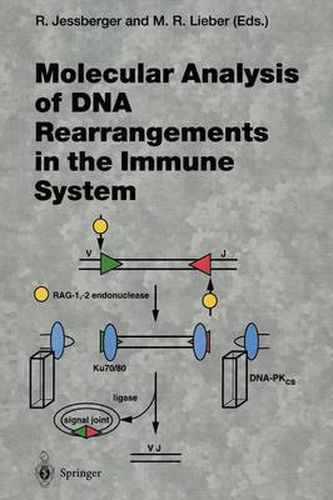Readings Newsletter
Become a Readings Member to make your shopping experience even easier.
Sign in or sign up for free!
You’re not far away from qualifying for FREE standard shipping within Australia
You’ve qualified for FREE standard shipping within Australia
The cart is loading…






This title is printed to order. This book may have been self-published. If so, we cannot guarantee the quality of the content. In the main most books will have gone through the editing process however some may not. We therefore suggest that you be aware of this before ordering this book. If in doubt check either the author or publisher’s details as we are unable to accept any returns unless they are faulty. Please contact us if you have any questions.
The vertebrate immune system is distinctive among defense systems of multicellular organisms. In addition to nonspecific immunity, it generates a randomized array of millions of antigen receptors (immunoglobulins and T-cell receptors). A subset of these receptors are critical for binding to invading microbes or biochemicals from them to tag the microbes for elimination. Three site-directed DNA modification processes are critical to this process in vertebrates. V(D)J recombination generates the array of exons that encode the antigen binding pockets. Recent work summarized in this volume describes the dissection of this process at the biochemical level. The mechanism of the reaction is now understood in considerable detail. The proteins that catalyze many steps of the process have now been identified by biochemical and genetic recon stitution and by analysis of genetic mutants defective in V(D)J recombination. Class switch recombination is the process by which the variable domain exon of the heavy chain is changed from IgM to IgG, IgA. or IgE. Recent progress is described in the de velopment of an extrachromosomal substrate assay system. Molecular genetic analysis of the process in transgenics is defining some of the cis sequence requirements. Biochemical assays for defining enzymatic components are also described. In addition to exciting progress in V(D)J recombination and class switch recombination, one chapter describes recent pro gress in somatic hypermutation.
$9.00 standard shipping within Australia
FREE standard shipping within Australia for orders over $100.00
Express & International shipping calculated at checkout
This title is printed to order. This book may have been self-published. If so, we cannot guarantee the quality of the content. In the main most books will have gone through the editing process however some may not. We therefore suggest that you be aware of this before ordering this book. If in doubt check either the author or publisher’s details as we are unable to accept any returns unless they are faulty. Please contact us if you have any questions.
The vertebrate immune system is distinctive among defense systems of multicellular organisms. In addition to nonspecific immunity, it generates a randomized array of millions of antigen receptors (immunoglobulins and T-cell receptors). A subset of these receptors are critical for binding to invading microbes or biochemicals from them to tag the microbes for elimination. Three site-directed DNA modification processes are critical to this process in vertebrates. V(D)J recombination generates the array of exons that encode the antigen binding pockets. Recent work summarized in this volume describes the dissection of this process at the biochemical level. The mechanism of the reaction is now understood in considerable detail. The proteins that catalyze many steps of the process have now been identified by biochemical and genetic recon stitution and by analysis of genetic mutants defective in V(D)J recombination. Class switch recombination is the process by which the variable domain exon of the heavy chain is changed from IgM to IgG, IgA. or IgE. Recent progress is described in the de velopment of an extrachromosomal substrate assay system. Molecular genetic analysis of the process in transgenics is defining some of the cis sequence requirements. Biochemical assays for defining enzymatic components are also described. In addition to exciting progress in V(D)J recombination and class switch recombination, one chapter describes recent pro gress in somatic hypermutation.